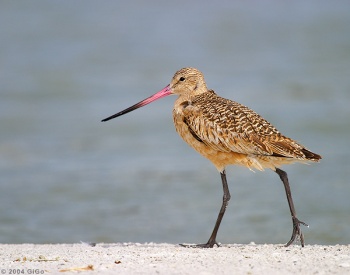- Limosa fedoa
Identification
Length 44 cm (17½ inches), Wingspan 71cm (28 inches)
Long blue-grey legs, very long pink based bill (orange in breeding plumage) with a slight upward curve and dark at the tip. Neck, breast and belly are cinnamon-buff with dark bars on the underparts in breeding plumage. The back is mottled cinnamon-buff and black. Cinnamon wing linings in flight. Lacks ventral barring in winter plumage. Females average longer bill. Juveniles are similar to non-breeding adults but usually show contrasting paler wing coverts and deeply notched, not barred tertials.
Similar Species
Marbled is the largest of the godwits. Bar-tailed Godwit is smaller with longer primary projection and shorter legs. It lacks the rich cinnamon color of the Marbled Godwit. Long-billed Curlew has body color and pattern similar to Marbled Godwit, but is larger with very long decurved bill, not always evident when birds are sleeping.
Distribution
Breeds Alaska peninsula, Canadian and U.S. Great Plains; winters from California and the Carolinas south to Panama, with occasional records south to Venezuela and Colombia to Chile.
Taxonomy
Subspecies
This is a polytypic species. Two subspecies are recognized[1]
- L. f. beringiae - Smaller: breeds Alaskan Peninsula; winters coastal Washington to California
- L. f. fedoa - Larger: breeds Great Plains of North America; winters winters from California and the Carolinas south to Panama, rarely to South America.
Habitat
Mudflats, marshes, beaches. Short grass.
Behaviour
Diet
Diet includes insects and crustaceans, and parts of aquatic plants.
Breeding
Nests on the ground, usually in short grass. Lays early May to June, with arrival on breeding grounds ranging from mid April in North Dakota, later further north. Monogamous and both sexes incubate.
Vocalisations
Typical calls in winter are nasal, slightly crowing or laughing ah-ha or ah-ahk, or a single ahk. On breeding grounds gives a loud ger-WHIT in display flight.
References
- Clements, J. F., T. S. Schulenberg, M. J. Iliff, D. Roberson, T. A. Fredericks, B. L. Sullivan, and C. L. Wood. 2018. The eBird/Clements checklist of birds of the world: v2018. Downloaded from http://www.birds.cornell.edu/clementschecklist/download/
- Chandler, R. (2009). Shorebirds of North America, Europe, and Asia: A photographic guide. Princeton Univ. Press.
- Gratto-Trevor, C. L. (2000). Marbled Godwit (Limosa fedoa), version 2.0. In The Birds of North America (A. F. Poole and F. B. Gill, Editors). Cornell Lab of Ornithology, Ithaca, NY, USA. https://doi.org/10.2173/bna.492
- Van Gils, J., Wiersma, P., Kirwan, G.M. & Sharpe, C.J. (2018). Marbled Godwit (Limosa fedoa). In: del Hoyo, J., Elliott, A., Sargatal, J., Christie, D.A. & de Juana, E. (eds.). Handbook of the Birds of the World Alive. Lynx Edicions, Barcelona. (retrieved from https://www.hbw.com/node/53891 on 23 October 2018).
- Wikipedia contributors. (2018, July 26). Marbled godwit. In Wikipedia, The Free Encyclopedia. Retrieved 08:11, October 23, 2018, from https://en.wikipedia.org/w/index.php?title=Marbled_godwit&oldid=852050089
Recommended Citation
- BirdForum Opus contributors. (2025) Marbled Godwit. In: BirdForum, the forum for wild birds and birding. Retrieved 18 May 2025 from https://www.birdforum.net/opus/Marbled_Godwit
External Links
{{GSearch|1
GSearch checked for 2020 platform.1







